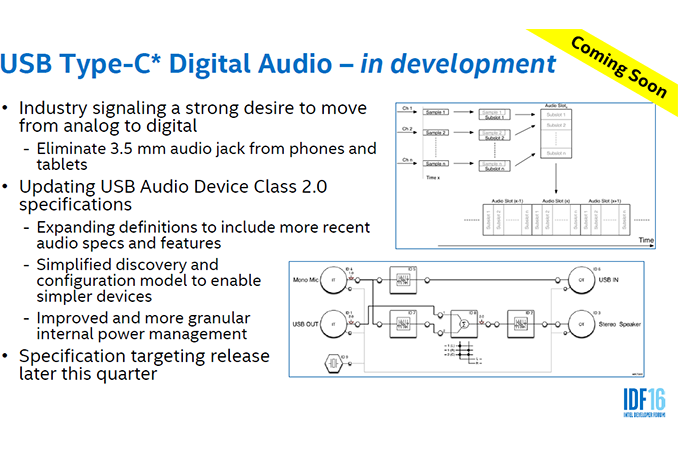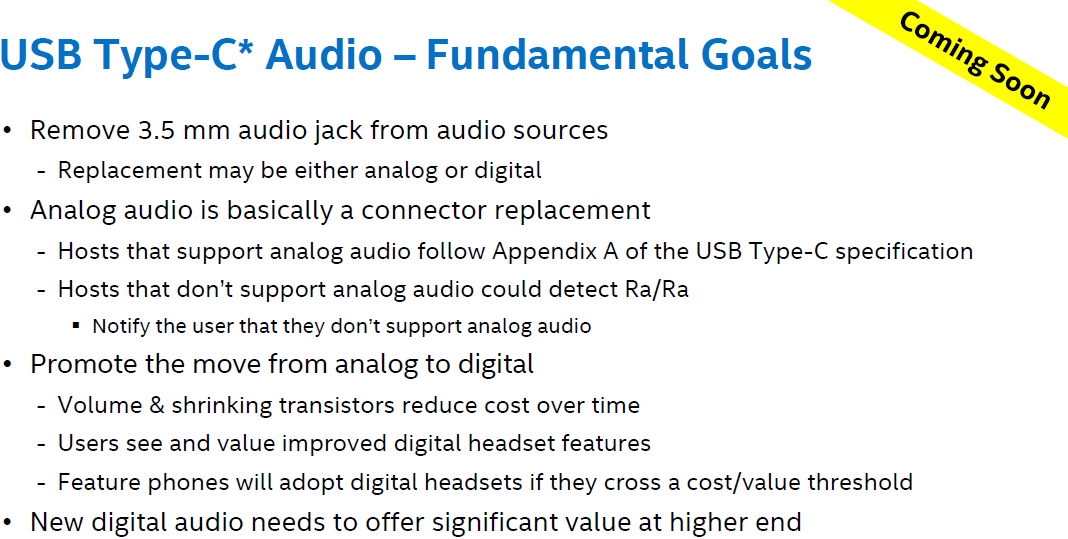Intel Proposes to Use USB Type-C Digital Audio Technology
by Anton Shilov on April 26, 2016 11:00 AM EST- Posted in
- Mobile
- Intel
- USB-C
- USB-C Digital Audio

USB Type-C has a number of chances to become the standard for data and charging connector for smartphones and tablets running either Android or Windows. However, in the long-term future, Intel wants USB-C to be even more universal (and therefore pervasive) than it is going to be, which is why at IDF Shenzhen part of one of the talks evolved around using Type-C for audio.
Audio receptacles on PCs and mobile equipment are virtually the last remaining analog interfaces of modern devices, requiring certain techniques to maintain a high audio quality and remove interference. Intel proposes to replace things like 3.5 mm mini-jack with USB Type-C which will help to add features to headsets and will simplify connections of multi-channel audio equipment to various gadgets. This is not the first time a company has proposed to replace analog audio on PCs and mobile devices, but so far, nobody has succeeded due to the ubiquity of 3.5mm. Since the industry may still not be ready to go all-digital, there seems to be a backup plan.
Various types of audio jacks to connect headphones to audio equipment have been around for decades. For example, the original 6.35 mm connector, which is still widely used by audio equipment, was invented in 1878. Meanwhile, two-conductor miniature 3.5 mm audio connector (which is the most widely used audio connector at present) has been around since 1960s. Headphone jacks have evolved; they have gained contacts to support microphones and even basic programmable capabilities to enable remote controls. However, fundamentally, the ability to listen to audio through a speaker has remained the same for over a hundred years: completely analog and barely any smart functionality. Today's smartphones are used for all sorts of different purposes and are connected to a variety of devices, which requires sophisticated interconnection technologies with high data-rates. At the same time, as phones and devices get thinner, or even to simplify some of the internal design, it gets harder to install multiple ports for various purposes. If there were to be a universal connector that does it all, including audio, Intel and some other players want USB Type-C to be that universal connector.
In fact, USB-C can be used to transfer analog audio in accordance with the specification of the connector. It all comes down as to how that audio is transmitted.
The USB-C has sideband use pins (SBU1 and SBU2) which can be used for analog audio in audio adapter accessory mode. Use of the sideband pins should not impact data transfers and other vital functionality of USB-C cables, which should make them relatively simple from the engineering point of view. In this case, the USB-C connector will just replace the 3.5 mm mini jack and may even gain some additional features, such as a thermal sensor in an earpiece could measure temperature for fitness tracking.
The concept is not completely new and we saw it years ago - back in the 2000s, Motorola used the mini-USB connector on its feature phones to enable charging, data transfers and a headset connection. The idea to use one connector for everything was not entirely bad, however, it left users without a choice of headsets. However, if the makers of devices (as well as producers of audio listening equipment) adopt USB-C, the is potential that the problem will not occur again. In the advent of digital signal transfer, this allows the headset to drive the digital-to-analog conversion, removing electronic interference from the host and potentially offering a wide array of audio results.
However, transferring analog audio using USB-C’s SBU pins is not the only thing that Intel is working on.
At present, Intel is finalizing the USB Type-C Digital Audio technology and plans to release its specification later in Q2. The company does not reveal a lot about the standard right now, but notes that it is working on updating the USB Audio Device Class 2.0 specifications to support new connector, expand the list of recent audio specifications and features, improve power management and simplify the discovery and configuration model to make the upcoming headsets as easy to use as today’s headsets.
In fact, one of the important issues with streaming audio over USB is the synchronization of data streams from the host to the receiver. The USB Audio Device Class specification solved the problem in the past and because Intel mentioned the USB Audio Device Class 2.0 in its presentation at IDF, this may mean that the new the USB-C Digital Audio spec will rely on this synchronization mechanism as well. Intel wants its USB-S Digital Audio to be backward-compatible with USB Audio (1.0 and 2.0), but naturally plans to add support for new music formats.
Usage of digital audio means that headsets should gain their own amplifiers, DACs and various other logic, which is currently located inside smartphones. Intel proposes to install special multi-function processing units (MPUs), which will perform beam forming, noise suppression, acoustic echo suppression (AES), acoustic echo cancellation (AEC), non-linear processing and other operations. The MPUs will also support HDCP technology, hence, it will not be possible to make digital copies of records using USB-C digital headset outputs. It is unlikely that audio processing will be offloaded to external headsets completely, but the latter will clearly gain their own chips. This may, however, see a spike in cost, especially at the super-low end.
A good thing about USB Type-C headsets with MPUs is that they are going to be software upgradeable and could gain functionality over their lifespan. Intel admits that such MPUs will make digital headsets more expensive compared to analog devices, but high volumes and new process technologies will help to reduce the cost of digital headsets over time. In fact, USB Audio headsets and audio chips for them are not something completely new. For example, Plantronics Audio 655 DSP headset costs $49.99, whereas CMedia’s HS-100 chip for headsets is available $1. Therefore, from the cost perspective, digital headphones should not be too much more expensive in general. Meanwhile, Intel wants USB-C digital audio headsets to offer “significant value at higher end” and have improved functionality in a bid to become popular among consumers.
The industry has successfully replaced analog cables with HDMI for video equipment in the living room and in the coming years will retire the D-Sub interconnection for computer displays. However, audio jacks have survived multiple generations as other standards have changed. In fact, Intel itself eliminated analog audio jacks in its first-generation NUCs PCs, but had to return them in subsequent generations. With USB-C Digital Audio Intel may not be alone. Google’s Android 5.0 already supports USB DAC devices and thus digital headsets. Moreover, last week LeEco released several smartphones without audio jacks, so, there are attempts to eliminate them from mobile devices already. One maker will not make any difference, but a coordinated move by market leaders, such as Samsung, LG or HTC, could have a significant impact.
Source: Intel



















148 Comments
View All Comments
boeush - Thursday, April 28, 2016 - link
No it can't be easily done with just software. The way sound bounces and refracts around the head and the pinna (the ear ridges/cavities) is unique to each individual because those geometries are individually unique like fingerprints, and each individual's brain has learned how to interpret those individually unique distortions to infer the 3D soundscape.So no software-driven stereo emulation of 3D sound will ever actually match the real 3D sound experience. It could crudely approximate it, sure - but will never be nearly as good.
cm2187 - Saturday, April 30, 2016 - link
And to be honest not very useful. I think if you ask people what the prefer between having to replace their headphone to have a thinner device and 5.1 audio vs keeping their stereo headphone, same thickness but better battery life, battery life will beat 5.1 by a huge margindarkfalz - Wednesday, April 27, 2016 - link
So, headphones would need to contain their own DAC and amplifier? Good luck with that. Also no ability to charge and listen at the same time?boeush - Wednesday, April 27, 2016 - link
Bluetooth headphones already do the same.As far as charge while listening, either two ports on the phone or some kind of a Y-splitter adapter/hub would do the trick (and USB has always been all about hubs, after all...)
Xajel - Thursday, April 28, 2016 - link
As long as they will put 2 Type-C's in the phone, It's okay... only one !! not another MacBook stupid thing please...And If we ask ( How can we charge and use the headphone in the same time ? )
The answer will be ( You can buy an adapter that can do this for only 39.99 ).
And we add ( We don't want to carry an adapter !! )
The answer will be ( You can buy a bluetooth headset then ).
Another cost, it's either in-the-box without changing the price or just put another type-C connector, or just keep the 3.5 there...
Or make the in-the-box Type-C cable already has the adapter built-in
cm2187 - Saturday, April 30, 2016 - link
And then how do you charge the blutooth headset and listen to music at the same time. I already have way too many batteries to babysit in my life already.theMediaman - Thursday, April 28, 2016 - link
Awesome article. There are a lot of fluffy pieces out there about Intel's announcement, but yours is technical and well explained. Bookmarking this.pseudoid - Thursday, April 28, 2016 - link
"A good thing about USB Type-C headsets with MPUs is that they are going to be software upgradeable and could gain functionality over their lifespan."Yeah, like when I bought first 4M DigCam, I was okay with the fact that it needed a firmware upgrade. Then, I found that the telephoto lens ALSO needed a FW upgrade that I realized I had enough of having to continually upgrade electronics. Why can't software designers can't figure out software that requires no 'upgrades'? If they could only make it right the first time like hardware designers.
And you are now telling me that I gotta firmware upgrade my headphones?????
cm2187 - Friday, April 29, 2016 - link
This is absolutely ridiculous.1. It means I will have to choose between either having an external storage attached to my device, or an ethernet connection, or a headset, but none simultaneously
2. It means that if I have my current laptop, a tablet, an iphone 7, I will need not two but THREE different headsets, one for the laptop's audio jack, one for the iPhone's lighting port, and one for the tablet's USB-C port.
This is R-I-D-I-C-U-L-O-U-S!
Magic Man - Friday, April 29, 2016 - link
There is just no reason to switch headphones away from analogue jacks. They are analogue devices. Sure, have digital/USB connected headphones for such purposes but headphones used purely to listen to the output of a device had no need to be anything more just as there is no need to make connections to speakers digital.I have an external DAC/AMP that I plug headphones into, I neither want nor have any need to replace that with some standard DAC/Amp combo in the headphone itself - it's utterly pointless. The drivers in the headphone are still analogue and would still be connected to such an internal DAC/Amp in exactly the same way electrically as they are now